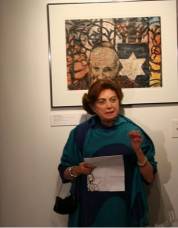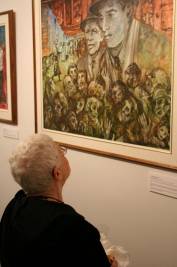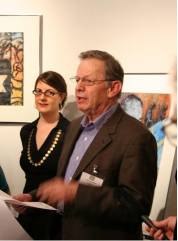Holocaust Survivors, art connoisseurs, members of The Jewish community, and press representatives gathered on January 17, 2010, at the recently inaugurated cultural space of the International Raoul Wallenberg Foundation for the opening of ”The Wallenberg Series” exhibit.
Showcased in its totality for the first time in the U.S., ”The Wallenberg Series” by Austro-Canadian artist Armand Frederic Vallée was organized to commemorate the 65th anniversary of the disappearance of Swedish diplomat Raoul Wallenberg at the hands of the Soviet troops on January 17th, 1945.
”Writers, composers, filmmakers, painters, and sculptors have found Wallenberg’s deeds, courage and values as the point of departure and motivation to create,” highlighted Daniela Bajar from the IRWF when introducing artist Armand Vallée’s work. ”With the opening of this Cultural Space, we hope to provide artists and their pieces the opportunity to tell these courageous stories,” she concluded.
Following Ms. Bajar’s speech, Dr. Mordecai Paldiel, IRWF’s Senior Research Consultant pointed out the importance of finding out what happened to Raoul Wallenberg after he was supposed to hold a meeting with the Soviet military to discuss the fate of the Jewish refuges 65 years ago, but he also stressed that ”perpetuating the memory on this outstanding person’s deeds, is maybe more important than knowing where he was buried. His deeds are going to stay with us and serve as role models of goodness.” Dr. Paldiel also gave a short overview of the cases of rescuers that the IRWF has recently researched, honored and conveyed to Yad Vashem. Some cases have already been honored with the ”Righteous among the Nations” title, others are waiting to be evaluated by Yad Vashem’s commission. ”It is the time to honor the people who saved lives and acted in spirit of Raoul Wallenberg, before it is too late,” Dr. Paldiel concluded.
The program continued with Rebbetzin Judith Friedlander from the Lisker Congregation who gave a touching account on the day when she accompanied her father, the Lisker rabbi, for a meeting with Wallenberg who gave them the Schutz-pass they later on forged, and thus managed to provide the protection for the members of their community. ”I waited 65 years to say ‘thank you’ to this great man,” said Rebbetzin Friedlander, standing in a room full of people and among the paintings that reminded her so much of the Budapest of her childhood.
Created in 1985/86, ”The Wallenberg Series” consists of fourteen paintings that narrate the Swedish diplomat’s quest to save victims. ”The fact that the artist has not been able to finish the last painting of the series seems to speak of his difficulty to cope with Wallenberg’s own unfinished story,” stated the IRWF Founder Baruch Tenembaum, upon studying the paintings.
The series was donated to the Wallenberg Foundation by Liesel Paris, trustee of Mr. Vallée’s estate, following the artist’s passing in February 2009. ”I made it my responsibility to respect Armand’s wish to exhibit ‘The Wallenberg Series ‘at the International Wallenberg Foundation in New York,” stated Ms. Paris.
Backed by the War Refugee Board, an organization that was headed by President Franklin Roosevelt, Raoul Wallenberg traveled to Budapest in 1944 with the aim of rescuing what was left of the Hungarian Jewry. Wallenberg was responsible for the survival of tens of thousands of people before his mysterious disappearance by the Soviet Army on January 17, 1945. Despite several accounts of his status as a prisoner over the years, the Soviet and now Russian government has yet to produce a satisfactory explanation as to Wallenberg’s fate and whereabouts.
”The Wallenberg Series” is the one of the many series of programs designed by the IRWF to promote Wallenberg’s values through art, and is going to be open on weekdays from 1pm to 5pm till January 29th, 2010.



